Night of the Laughing Dead: Man-Thing 5 and 6
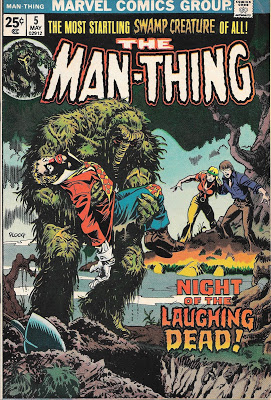
Redartz: Good day, fright fans! In honor of the upcoming Halloween Holiday, today we will revisit an excellent 2-parter featuring Marvel's own denizen of the dismal swamps, the Man-Thing. Issue 5 was the first 'monster' book I ever bought (truth be told, at the time I only bought it for the Marvel Value Stamp- yes, they led this fan to spend extra quarters on unfamiliar comics). Upon reading this issue, and the subsequent one with the story's conclusion, I was hooked on ol' Manny, and followed his book for years...
As our story opens, we see a pretty downcast clown, Darrell, who proceeds to 'take the last train out'.
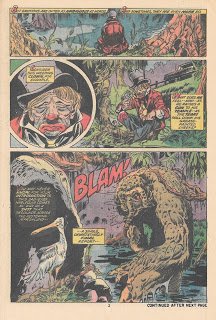
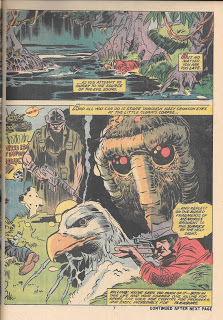
The Man-Thing is attracted by the sound of the gunshot, and soon stumbles upon the tragic scene...
Prodded by vague memories of 'funerals', Man-Thing carries off the body.
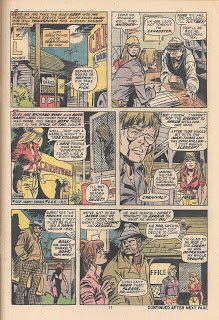
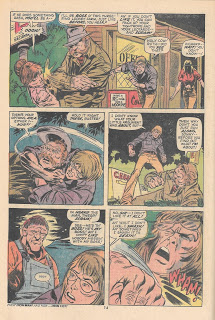
Meanwhile, Manny's friend Richard Rory and his companion Ruth Hart encounter Ayla, Darrell's love and fellow circus performer, along with Tragg (the strongman) and Garvey, the rather unsavory owner.
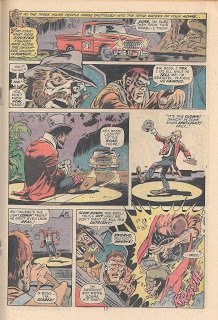
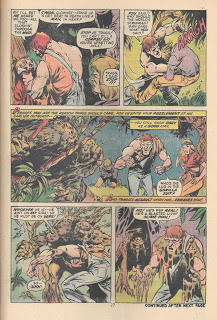
Ayla flees the circus, along with Richard and Ruth. We learn that Darrell was devastated, mistakenly thinking Ayla had deceived him with Garvey. Ayla, fearful for Darrell' well-being, drags Richard and Ruth into the swamp , only to find his body being carried by the Man-Thing. Meanwhile, Garvey and his thug Tragg have followed them all. Unfortunately, they wreck their truck after swerving to avoid what they thought was Darrell, dancing in the roadway. Garvey and Tragg follow the 'clown' and find the group gathered around Darrell's body. When Tragg tries to lay into the clown, Richard intervenes, and gets clobbered for it. Man-Thing goes to defend his friend, and as he and Tragg trade slime, something distracts everyone:
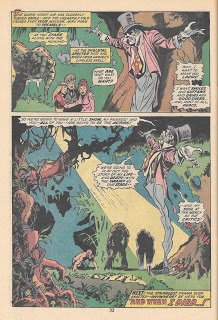
At this point, Darrell's spirit rises from his body, and informs the group that they will all be actors, portraying the characters in Darrell's past life. The performance will be judged by the "critics", who will then decide Darrell's soul's ultimate fate.
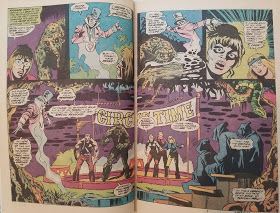
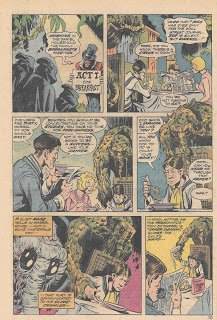
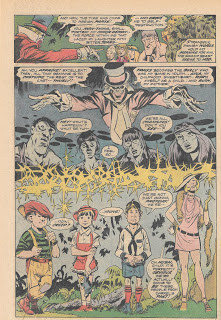
The spectral clown transforms the cast , Man-Thing portraying Darrell's 'inner demon'. Appropriately, as Man-Thing senses emotion, as opposed to understanding words, and can 'feel' Darrell's conflicts. The Spectral Darrell then directs scenes from his past, from boyhood through teenhood, and into adulthood.
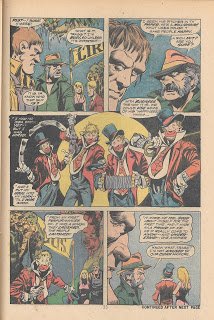
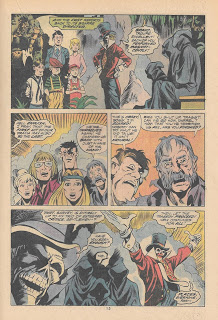
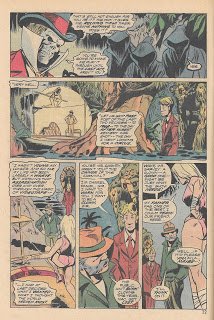
The reasons for Darrell's deep depression becomes apparent to everyone. However, the 'critics' decide he failed to justify his suicide and prepare to discard his soul. These 'critics' are revealed as representatives of Heaven, Hell and Purgatory. At this point Man-Thing intervenes (empathetically defending Darrell and his soul), and battle ensues. But Ayla ceases the clamor with her plea for Darrell, and the 'critics' are finally convinced. And Darrell's corpse smiles.
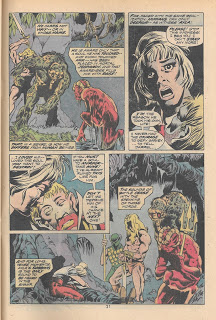
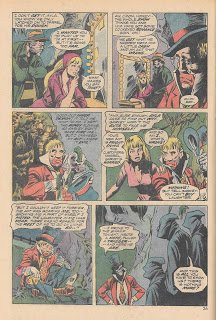
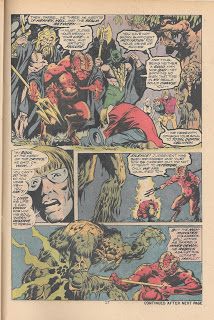
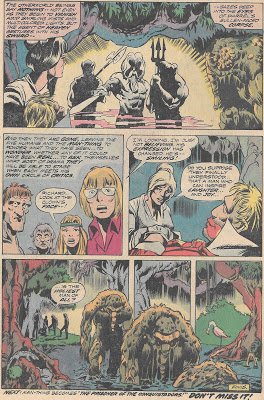
Steve Gerber (one of my favorite Bronze age storytellers) approaches this title almost like an anthology series, with each story revolving around the supporting cast (primarily Richard Rory and Ruth Hart) and the particular new characters introduced for that specific tale. The Man-Thing himself often (but certainly not always) acts as a metaphor for justice, perhaps, or fate, or as a 'deux et machina'. In this story, he (literally) acts as Darrell's inner demon, and at story's end takes action to defend the soul he had shared.
The first half of the story, in issue 5, is mainly down -to- swampy earth creepy fare, introducing the colorful cast of circus members and following their conflict with and pursuit of the unfortunate Darrell. Incidentally, when I first read this at age 13, it seemed pretty intense- suicide being such a central element of this comic book story. Gerber excels at portraying conflicted, unorthodox, even convoluted characters. Many such characters are found in his Defenders and Howard the Duck books, often with a lighter (or more fantastic, anyway) tone. But in this story these characters are 'regular people' (ghost clowns being excepted, of course), and their turmoils seem deadly serious. When the Headmen face the Defenders, there is a distinct humorous touch. Conversely, when Tragg gut-punches Rory, it's no laughing matter.
The second half of the story (issue 6) has a very different tone. Much of the issue is taken up by the mystical performance of Darrell's life by the transmogrified cast, and by the final battle with the emissaries of heaven, hell and purgatory. We aren't told how those transformations are done- it's just accepted as part of the spiritual events of the story. Just as we accept Darrell's spirit rising from the corpse, and we accept the appearance of the denizens of the Afterlife. The whole ghostly performance is a chance for Gerber to explore some issues of Troubled Youth (something he dealt with often). The two halves of the story complement each other nicely, balancing the earthly with the spiritual.
As for the artwork: in a word, perfect. Mike Ploog gives an almost cartoony look to the scenery and cast, just ideal for depicting Gerber's slightly off-kilter world. His Man-Thing is terrific, his Tragg suitably thuggish. And his spectral clown Darrell is beautifully creepy. Frank Chiaramonte's inks work well. Not overpowering, letting Ploog's pencils shine, and also providing some nice use of blacks and shadow.
Additionally, a point should be made about Ploog's renditions of people in general. His men and women look like 'ordinary folks', as opposed to appearing as eye-pleasing models rendered by, say, a John Romita. Ploog's characters have wrinkles, sags, flaws. All the better to make them more identifiable and sympathetic to the reader, especially when placed in some pretty far-out situations such as Gerber creates.
This little two-parter made me a Man-Thing reader for good. "Man-Thing" is, in a way, like Spider-Man: the supporting cast is as important as the main character. Richard Rory is one of those 'likeable losers', and his friendship with Manny is both heartwarming and quite odd. Those odd elements abounded in Gerber's books, and some worked better than others. In this tale, though, all those elements coalesced into a very eerie, very memorable, very enjoyable story.